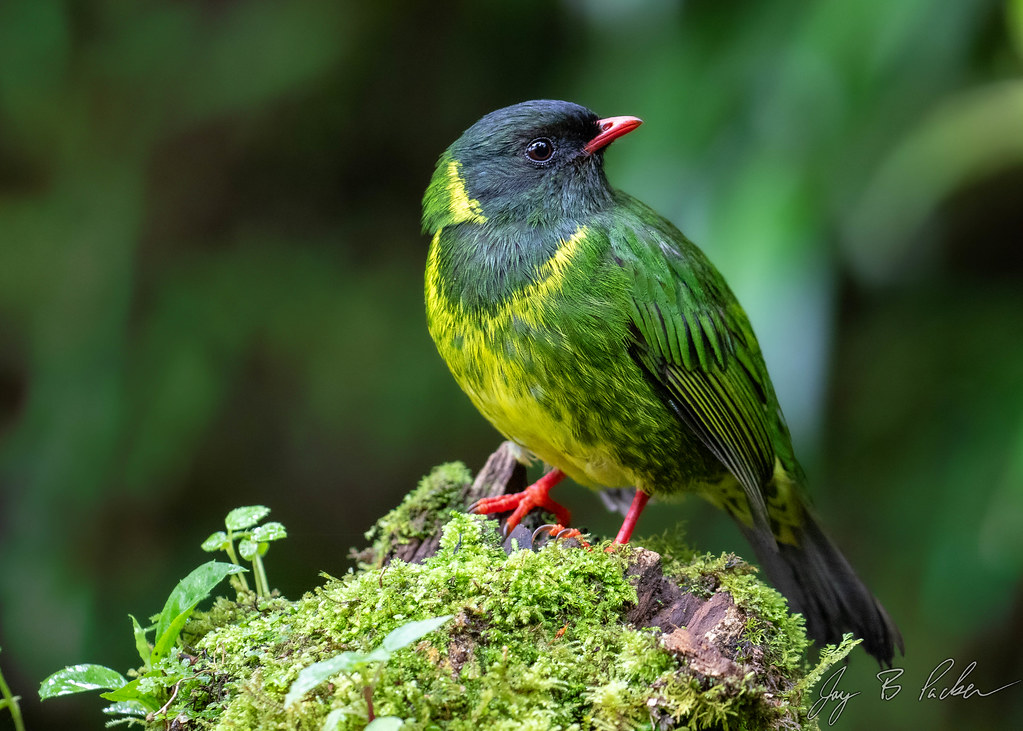#diapsida
Text

Araeoscelis gracilis was a superficially lizard-like animal that lived during the mid-Permian, around 275 million years ago, in what is now Texas, USA. About 60cm long (~2'), it had a slender body, proportionally long legs, and a solidly-built skull with strong teeth, suggesting that it was a fast runner that specialized in cracking open the carapaces of thick-shelled prey.
It was one of the last known members of a lineage known as araeoscelidians, which are usually considered to be very early members of the diapsid reptiles – but a recent study has proposed they might have even more ancient roots than that, possibly being a branch of stem-amniotes instead.
———
NixIllustration.com | Tumblr | Twitter | Patreon
#science illustration#paleontology#paleoart#palaeoblr#araeoscelis#araeoscelidae#araeoscelidia#diapsida#reptile#amniote#art#lov the cronch
315 notes
·
View notes
Video
Munchique Wood-Wren by Jay Packer
Via Flickr:
Endemic to the western Andes of Colombia, this highly sought-after wood-wren is found at higher elevations than the similar Gray-breasted Wood-Wren. Montezuma Road, Tatamá National Park, Colombia
#Animalia#Amniota#Aves#Reptilia#Vertebrata#Archosauromorpha#Chordata#Diapsida#Tetrapoda#Munchique Wood-Wren#Colombia#Troglodytidae (Wrens)#Passeriformes#South America#Animals#Birds#Henicorhina negreti#flickr
12 notes
·
View notes
Text

Gracilicollum
Gracilicollum — рід ймовірних таністрофеїдних архозавроморфів з середньотріасової (анізій) формації Гуаньлін у Китаї. Рід містить один вид, G. latens, відомий за черепом і частковою шиєю.
Повний текст на сайті "Вимерлий світ":
https://extinctworld.in.ua/gracilicollum/
#gracilicollum#triassic#archosauromorpha#china#reptiles#ua#diapsida#asia#art#paleontology#paleoart#prehistoric#animals#animal art#extinct#article#digital art#fossils#illustration#палеоарт#палеонтологія#ukraine#ukrainian#україна#мова#арт#українська мова#наука#китай#тварини
36 notes
·
View notes
Photo

Character Concept Reference, 2020
#oc#original character#original art#leopard gecko#cockatiel#my art tag#artists on tumblr#diapsida#drawing#art#draw#support small artists
2 notes
·
View notes
Photo
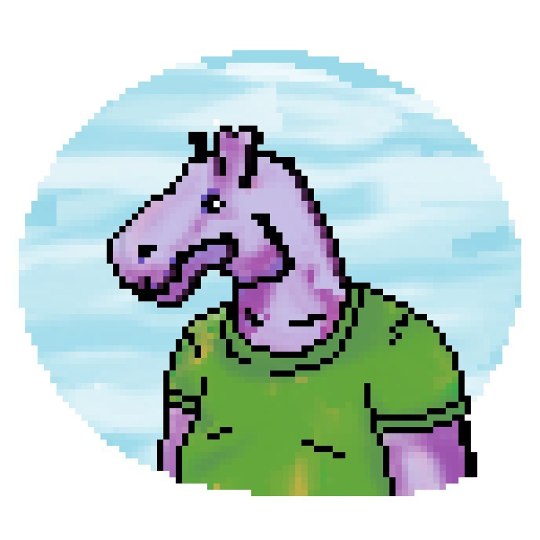
█ Pay_de_Menta_-_ESTEMMENOSUCHUS.bmp █ Haciendo un poco de pixel de nuevo 🤓👾Ilustrando al Estemmenosuchus, un sinápsido del pérmico medio █ #art #myart #myartwork #paleontology #synapsids #synapsida #diapsida #diapside #estemmnosuchus #pixel #pixelart #8bit #8bitart #paleoart #illustration #artoninstagram #illustrationoftheday #ilustracion #ilustraciondigital #popart #ilustradoresmexicanos #artedigital #digitalart #artepop #ilustração #ilustrazione #paleoarte #illistrationoninstagram #diapsidé #myart🎨 https://www.instagram.com/p/CkwoWLpDy9S/?igshid=NGJjMDIxMWI=
#art#myart#myartwork#paleontology#synapsids#synapsida#diapsida#diapside#estemmnosuchus#pixel#pixelart#8bit#8bitart#paleoart#illustration#artoninstagram#illustrationoftheday#ilustracion#ilustraciondigital#popart#ilustradoresmexicanos#artedigital#digitalart#artepop#ilustração#ilustrazione#paleoarte#illistrationoninstagram#diapsidé#myart🎨
0 notes
Note
Birds are class Aves.
Sure, under Linnaean taxonomy. But, well,
A) Linnaeus was a eugenecist so his scientific opinions are suspect and his morality is awful
B) he didn't know about evolution
C) he didn't know about prehistoric life
so his classification system? Sucks ass. It doesn't work anymore. It no longer reflects the diversity of life.
Instead, scientists - almost across the board, now - use Clades, or evolutionary relationships. No rankings, no hierarchies, just clades. It allows us to properly place prehistoric life, it removes our reliance on traits (which are almost always arbitrary) in classifying organisms, and allows us to communicate the history of life just by talking about their relationships.
So, for your own edification, here's the full classification of birds as we currently know it, from biggest to smallest:
Biota/Earth-Based Life
Archaeans
Proteoarchaeota
Asgardians (Eukaryomorphans)
Eukaryota (note: Proteobacteria were added to an asgardian Eukaryote to form mitochondria)
Amorphea
Obazoa
Opisthokonts
Holozoa
Filozoa
Choanozoa
Metazoa (Animals)
ParaHoxozoa (Hox genes show up)
Planulozoa
Bilateria (all bilateran animals)
Nephrozoa
Deuterostomia (Deuterostomes)
Chordata (Chordates)
Olfactores
Vertebrata (Vertebrates)
Gnathostomata (Jawed Vertebrates)
Eugnathostomata
Osteichthyes (Bony Vertebrates)
Sarcopterygii (Lobe-Finned Fish)
Rhipidistia
Tetrapodomorpha
Eotetrapodiformes
Elpistostegalia
Stegocephalia
Tetrapoda (Tetrapods)
Reptiliomorpha
Amniota (animals that lay amniotic eggs, or evolved from ones that did)
Sauropsida/Reptilia (reptiles sensu lato)
Eureptilia
Diapsida
Neodiapsida
Sauria (reptiles sensu stricto)
Archelosauria
Archosauromorpha
Crocopoda
Archosauriformes
Eucrocopoda
Crurotarsi
Archosauria
Avemetatarsalia (Bird-line Archosaurs, birds sensu lato)
Ornithodira (Appearance of feathers, warm bloodedness)
Dinosauromorpha
Dinosauriformes
Dracohors
Dinosauria (fully upright posture; All Dinosaurs)
Saurischia (bird like bones & lungs)
Eusaurischia
Theropoda (permanently bipedal group)
Neotheropoda
Averostra
Tetanurae
Orionides
Avetheropoda
Coelurosauria
Tyrannoraptora
Maniraptoromorpha
Neocoelurosauria
Maniraptoriformes (feathered wings on arms)
Maniraptora
Pennaraptora
Paraves (fully sized winges, probable flighted ancestor)
Avialae
Avebrevicauda
Pygostylia (bird tails)
Ornithothoraces
Euornithes (wing configuration like modern birds)
Ornithuromorpha
Ornithurae
Neornithes (modern birds, with fully modern bird beaks)
idk if this was a gotcha, trying to be helpful, or genuine confusion, but here you go.
all of this, ftr, is on wikipedia, and you could have looked it up yourself.
671 notes
·
View notes
Note
I think I'm about to start a debate with this but are. Chickens reptiles because I know they can have salmonella
This isn't even a debate anymore in herpetological circles - all birds are reptiles! (But it's not because they can also have salmonella; most mammals can also have salmonella.) The tl;dr is that birds are dinosaurs, dinosaurs were reptiles, ergo birds are reptiles.
Here's a very simple reptile family tree I drew to help explain why:
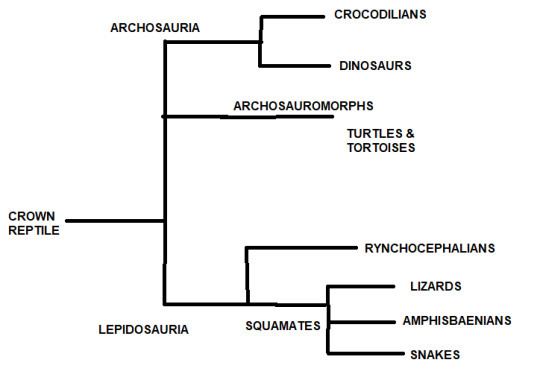
From the crown reptile, which is the common ancestor of all reptiles, we have two major branches - our superorders. The first are the archosaurs. Archosauria has two main branches - crocodilians and dinosaurs. Crocodilians are very closely related to dinosaurs, but it's only about as closely as lizards are related to snakes.
Any classification that includes crocodilians as reptiles must also include birds, because they are on the same branch of the reptile family tree. If you want to exclude birds, fine, you can make an argument that only the Lepidosaurs belong in Reptilia (that’s snakes, lizards, tuatara, and amphisbaenians). But there’s no way to include crocodilians and even turtles in there while excluding birds - crocodiles and birds are more closely related to each other than to any other living reptiles, after all.
Basically, the question really does come down to two options. Either birds are reptiles, or crocodiles and turtles aren’t. If we’re going to classify animals based on evolutionary history, then there’s really no point in half-assing it! The fact of the matter is that birds are more closely related to reptiles than to any other group, and they’re still part of Diapsida, a group which includes all other living and extinct reptiles.
239 notes
·
View notes
Text
Dinosaurs are not extinct.
The fact that Dinosaurs, the rulers of Mesozoic earth are extinct is not at all a 'news' to you, right?
Yeah, I mean considering you or your distant cousins belong to the Holocene earth and actively taking part in this Anthropocene, you have been technically taught right since your childhood, that YES! DINOS, THE GIANT LIZARDS ARE EXTINCT. And, even if I write something on this, won't make a big deal. But what will make quiet a big deal is, if I write and actually go onto claim that NO! DINOSAURS AREN'T EXTINCT! Now this is what that sixth grader would say, "Yes, I want more of this... go on I'm listening."
By now, you might be thinking that this is a big statement I have made. But what if I tell you, go and ask this same question to a paleontologist or maybe some evolutionary biologist. Trust me, try it out and you'll see, it's not much of a shock to them as it was to you. Dinosaurs are not extinct, they know it. But do they say it? NO (and this is what this blog is all about)
You see, in the world of Paleontology or (to be more precise)Dinosaur Paleobiology there are two very vaguely defined things. And by saying, 'very vague' it's actually quiet serious. I mean if at least one of these two would have been crystal clear to us, I wouldn't have been writing this blog today.
First, the very meaning of the word Dinosaur! yes... it literally means "A Giant Lizard" (as you all might already know). Why Sir Richard Owen, why did you do this? I mean there's a whole different story to this though, but yeah the great paleontologist of his time could have come up with something more better and clearer.
Now, if you are that average sixth grader wondering what's actually wrong with A GIANT LIZARD, well let me shatter your childhood learnings and say that, dinosaurs are related to lizards but not that related enough to actually call them lizards!
Avoiding, scientific stuffs here (you'll get bored otherwise) let me get this straight. Assuming you are aware of a phylogenetic tree, look at this below -
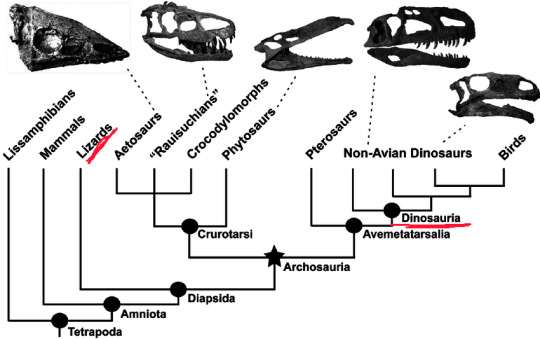
Just look at where Lizards and the group of Dinosauria or Non Avian Dinosaurs are! In our planet's great evolution story (with regards to Geological Time Scale of course), lizards and dinosaurs both went on to follow separate paths of development.
Now the sixth grader might argue, "Oh cmon! but they do have a common ancestry at some point right, like mentioned here as Diapsida?" Well its true, but going with this, it all comes down to that one single-celled microorganism or maybe that RNA molecule made of just proteins from which life eventually began and the fact then becomes, YOU are also a lizard or fish or any insect. Not so happy with that ain't you. Trust me, my brain's okay digesting this but you or an average sixth grader won't be proud calling themselves a disgusting house fly :)
This is what I call 'A Game of Perspective'.
Perspective, to actually define events with regards to our evolutionary history. This is... what I feel, the most difficult thing to do in paleontology, apart from the fact that you define something one day and tomorrow you dig something out related to your newly defined 'thing' which actually makes you rewrite the whole definition, previous day going in vain.
Hence, the giant lizard, based on the above phylogenetic tree, does live. It's not at all extinct. Komodo dragon, take this for an example if you aren't satisfied with your house lizard. Now, this obviously doesn't bring back the famous Tyrannosaurus Rex or Velociraptor right? They are indeed extinct. But, if you are attentive enough to actually see 'Birds' in the above phylogenetic tree branching out of the Dinosauria group, ask yourself, "Is the chicken, that I love to eat from KFC extinct?"
The answer is an undebated NO and this is where the 'second vague' thing comes in - Where to draw the line and define birds as a whole separate species?

Look at a closer division of Dinosauria in the above figure and you will see that 'Aves' has actually branched out from 'Theropoda', which itself has branched out from 'Saurischia'. Aves, is what you might already know, refer to the birds. Now the main point of confusion is at what point in evolutionary history did a chicken become a chicken from its theropod descendants. The game of perspective comes up here, and we look into the definition of birds with regards to theropods (group of Dinosauria), because we know that they are their evolutionary successors. (look at the above figures again if you still don't believe)
Birds as Archeopteryx and all of its descendants.
Pretty cool right? I mean if you follow paleontology to some extent you might know that Archeopteryx is the missing link fossil between a bird and a dinosaur. But is it a bird or a dinosaur?
More precise - Is Archeopteryx a bird or a theropod?
The issue here is, recent studies have shown that Archeopteryx is more related to Dromaeusaurids (a small clade of feathered dinosaurs) than modern day birds.
2. Birds as feathered dinosaurs.
As good as it may sound, feathers! It is the most confusing body part of a Dinosaur, because more and more fossils show that they had feathers attached to them. Even your favorite T-Rex is now believed to have it! (Note - Jurassic Park is just a movie, there's a whole lot more to dinosaurs than to just get chased by them in a park)
3. Birds as flying dinosaurs.
Again, it is difficult to determine exactly which dinosaurs were capable of flying (as opposed to simply gliding). Also from a modern perspective, penguins for instance don't fly. But they are birds!
4. Birds as crown dinosaurs, meaning the last common ancestor of all extant birds and its descendants.
This is somewhat the most favored definition by paleontologists till date, but the problem here is, it ignores many feathered and flying dinosaurs that are more closely related to modern birds than to Archaeopteryx as birds.

Just look at how the highlighted region fades as we go from modern birds towards Archeopteryx and so on.
So, YES... saying that the Ornithischian group of dinosaurs is extinct, isn't wrong at all. Even the Sauropod group of Saurischian dinosaurs are extinct. But the Theropods, the same evolutionary line of Tyrannosaurus Rex isn't extinct, unless paleontologists can actually draw the line to separate modern day birds from them.
Paleontologists are still trying to figure this line out and believe me, this is quite challenging. I would like to quote here, studying what's underneath is much more difficult than something just above your head. You see, your goal isn't far in paleontology... it's hidden and that's what makes it more difficult.
Now, is it even necessary to actually draw this line. I'm afraid it is, otherwise blogs like this will come up more and disturb the already disturbed lives of paleontologists, dinosaur paleobiologists out there.
And... till the time this line is drawn, respect the chickens that you eat as they are your living dinosaurs. (I mean, I am not promoting veganism here, but just respect them, yeah... can't think of anything else)
Figure References -
Figure 1 (in order) taken from Macroevolutionary patterns in the evolutionary radiation of archosaurs (Tetrapoda: Diapsida) by Stephen L Brusatte | September 2010 Earth and Environmental Science Transactions of the Royal Society of Edinburgh 101(3-4)
Figure 2 (in order) taken from www.opengeology.org | Image by Callan Bentley
Figure 3 (in order)taken from Dino101: Dinosaur Paleobiology 200/201 University of Alberta | Modified from Hackett et al.2008
If you have made it this far, thanks a lot. Feel free to ask me any dumb thing. Trust me, dumb questions often lead to great discoveries!
Anyways, this is it for my first blog.
For the love of Earth Science :D Byeee
23 notes
·
View notes
Note
Nvm never talk to me again

Birds are reptiles, Gabriel. Did you know this. Cuz I knew this.
They're diapsids, Gabriel. You know what else is diapsids? Literally every reptile on the planet.
Diapsida is the reptile order, Gabriel. Sauria is the dinosaur clade, a subsect of Diapsida. You know what's in the dinosaur clade, Gabriel? Aves. Avians. Birds.
Birds are dinosaurs, and birds are reptiles.
Birds are also in the Archosauromorpha clade. Do you know what's in that clade, Gabriel? Archosaurs.
Do you know what's considered an archosaur, Gabriel? Dinosaurs.
Do you know what the last living remnants of dinosaurs are, Gabriel? Crocodiles and birds.
Crocodiles are more closely related to birds than they are to lizards, Gabriel. Because birds are reptiles.
Birds are reptiles, Gabriel. I've had this knowledge for years and I haven't been the same since I learnt it.
6 notes
·
View notes
Text

Desert Banshee
Kingdom: Animalia
Phylum: Chordata
Class/Clade: Reptilia (Sauropsida)
Clade: Diapsida
Clade: Archosauria
Clade: Dinosauria
Clade: Saurischia
Clade: Eusaurischia
Clade: Theropoda
Clade: Neotheropoda
Superfamily: Coelophysoidea
Family: Coelophysidae
Subfamily: Allophysinae
Genus: Aravadromeus
Species: A. kakophonia (”dissonant runner of the Arava Desert”)
Ancestral species: Coelophysis bauri
Temporal range: late Pliocene to recent (3 mya - present)
Information:
While this creature superficially resembles an odd cross between a proceratosaurid and an ornithomimid, its origins actually lie far closer to the base of the theropod family tree: this odd creature is, in fact, a highly-derived coelophysid. Outside of its appearance, however, it has one notable difference: at some point within the last 30 million or so years, its lineage has made the switch from carnivory to herbivory. While the desert banshee feeds primarily on desert shrubs, fruits, leaves, and grasses, facultative carnivory has been observed: they are known to occasionally hunt and eat small birds, reptiles, and mammals, and females may do this leading up to when they lay their eggs. (But that’s a story for a little latter). As with many animals inhabiting the Arava Desert (though it also inhabits the grasslands and dry forests much further north in smaller densities and parts of the jungle to the east, though the latter may actually be a distinct but closely-related species), it is quite hardy, able to go long periods without food or water by storing fat in its tail.
In addition to their dietary switch, they have also developed unique behaviors to accommodate such changes: as the desert banshee is rather small, only around 8-9 feet in length, 3-4 feet at the hip, and around 70-80 lbs, it is a prime target for many desert predators, including the many species of carnivorous theropods and synapsids (including humans) who inhabit the region. As such, this animal is built for speed, being able to run up to 40 miles per hour in short bursts and preferring to flee from predators. However, if cornered or injured, it will not hesitate to put up a fight, making use of its two large ankle spurs to slash at its attackers. Additionally, it is nocturnal, preferring to travel at night to both avoid the scorching desert sun and to find new feeding grounds. While the obvious assumption would be that these animals would additionally flock together for protection, desert banshees deeply detest sharing space with congeners, and territorial confrontations can get bloody very quickly. However, it frequently travels with large flocks of ornithomimids for protection. The relationship this creature has with its larger distant cousins may be described as a form of commensalism: in exchange for protection, the desert banshee acts as a watchman of sorts to the ornithomimids, alerting the flock when predators are near with the deafeningly shrill, shrieking call that gave it its name. (Among its repertoire of other sounds are clucks and “drums” to communicate with its ornithomimid protectors long-distance and hissing when threatened or otherwise angered). In a rare example of non-primate social grooming, this creature will readily allow the ornithomimids it lives around to groom its feathers and remove parasites.
Just about the only time when these creatures will tolerate one another is when they are ready to mate: while these animals mate year-round, most mating occurs in late spring to early summer. With only slight sexual dimorphism, the males and females are not always easy to tell apart. Both have the same coloring: a white crest with black stripes, a white beak with black spots, creamy blue skin, dark blue spots on the wattle, grey feathers with black bands, and brown-to-black eyes. However, the female being able to distinguish herself by her warbling call which signals she is sexually receptive. Flashing his bright wattle, the male will flick his head up and down as part of a mating dance to get the female’s attention. If she accepts his display, the pair will walk side-by-side in synchronized movement, warbling and cooing while bobbing their heads up and down. After this display is over, the pair will mate and go separate ways. In the few weeks leading up to laying her clutch, the female may become facultatively carnivorous in order to obtain the calcium needed to produce her eggs. She will lay a clutch of 3-5 eggs in due time, and after a few weeks, they will hatch. However, she can retain the eggs inside her for an extended period of time until conditions are favorable or to synchronize the birth of her chicks with those of the ornithomimid flocks she follows. For the first 1.5 years of their life, the young are dependent on their mother as they reach near-adult age, at which point they are chased away and must find their own herd to follow. By 2.5 years, they will have reached sexual maturity and will be ready to mate, and if they can successfully avoid predators, they can expect to live 12-14 years in the wild and, if born in captivity, 20-30 years.
This species’ relationship with humans is one which is both riddled with mutualism and marred by tragedy: the desert banshee’s naturally social nature makes it exceptionally tame when raised in captivity, and some nomadic Lowland Xenogaean tribes keep them as their equivalent to sheepdogs. They are also known to be quite affectionate with their caretakers. Their ability to run fast in short bursts has also made them quite common as race animals which betters will gamble on. This species is also a frequent pest in the desert city of Tairokôna, where its habit of eating local crops and decorative plants have put it at odds with the city’s denizens. In addition to being used as a shepherd animal by Lowland Xenogaeans, they have also long been a source of food, with cut marks on fossil bones dated to around 50,000 years ago indicating that ancient humans in the area butchered and ate these animals. At one point, wild desert banshee numbers were driven so low due to pressures put on them by human hunters, that these animals experienced a bottleneck where smaller animals went on to breed and pass on their genes, meaning the modern population may be as much as 15% smaller than the Plio-Pleistocene variant of this species. Thankfully, its numbers have rebounded significantly in modern times, albeit they are still proportionally small and at risk of extinction in the wild, with only around 30,000 wild specimens across their entire range. At one point, this animal was also one of most trafficked and poached animals in the entire region, being hunted specifically for its bony crest in addition to its meat. Though its numbers rebounded significantly, there are a number of zoos and private collections across the world which still have illegally-bought desert banshees and their goods, particularly in the United Arab Emirates and Qatar. Even amongst Xenogaean aristocracy (Xenogaea being the larger of 1 of 2 nations inhabiting the archipelago), this animal is frequently seen as an exotic pet, and the King of Xenogaea, Tlahula I, has an entire stable of captive-bred desert banshees which have been selectively bred for several generations. Nowadays, most desert banshees killed for human consumption are captive-bred, with some debate over whether or not they may be undergoing domestication and if the captive-bred populations should be counted as a distinct species or subspecies from the wild one. However, the lack of morphological differences would seem to suggest that the captive-bred population are merely just that: captive-bred specimens of a wild species. Fossils of this species go back to at least the late Pliocene around 3 million years ago, though similar species are known from fossils in what is now the western grasslands as far back as the Eocene some 34 million years ago. Genetic divergence suggests it diverged from its closest living relatives over 150 million years ago, predating the split of most modern mammal lineages.
#novella#speculative evolution#fantasy#scifi#scififantasy#speculative biology#speculative fiction#speculative zoology#worldbuilding#fantasy worldbuilding#fantasy creature#sci fi creature#sci fi#scifi worldbuilding#creative writing#creature art#creature#coelophysid#coelophysis#dinosaurs#original species#spec evo
4 notes
·
View notes
Text
Mod 3 General Topics
Temporal Fosse in Reptiles
The class reptilia is divided into 5 subclasses on the bases of presence or absence certain openings through the temporal region of the skull.
Subclass I: Anapsida
Primitive reptiles with a solid skull roof. No temporal openings.
Subclass II: Euryapsida (extinct)
Skull with a single dorso-lateral temporal opening on either side, bounded by postorbital and squamosal bones.
Subclass III: Parapsida (extinct)
Skull with a single dorso-lateral temporal opening on either side bounded below by the supratemporal and postfrontal bones.
Subclass IV: Synapsida (extinct)
Skull with a single lateral temporal opening on either side bounded above by the postorbital and squamosal bones.
Subclass V: Diapsida
Skull with two temporal openings on either side separated by the bar of post orbital and squamosal bones.

Order Rhynchocephalia
Body small, elongated, and lizard like
Limbs pentadactyl, clawed, and burrowing.
Skin covered by granular scales and a mid-dorsal row of spines.
Skull diapsid. Nasal openings separate. Parietal foramen with vestigeal pineal eye present. Quadrate is fixed.
Vertebrae amphicoelous or biconcave. Numerous abdominal ribs present.
Teeth acrodont. Cloacal aperture transverse.
Heart incompletely 4-chambered
No copulatory organ in male.
Crop Milk
At the base of the neck and just in front of the sternum, the middle of the esophagus expands into a thin-walled, bilobed, elastic sac called the crop.
The crop serves as a food reservoir into which the hurriedly swallowed, dry and hard food grains are stored, moistened, and softened.
Pigeons have a unique ability to produce 'crop milk', a soft cheesy and nourishing secretion. Both sexes can produce it, especially during breeding season.
It is formed by the degeneration of the epithelial cells lining the crop.
It is regurgitated into the mouth of the young bird till they are old enough to manage a grain-diet like their parents.
Prolactin hormone, secreted by the anterior lobe of the pituitary gland, stimulates and controls the formation of crop milk.
Crop milk contains water, protein, fat, lactose, and ash.
Some parrots, flamingos, and penguins also produce crop milk
Flight Adaptations in Birds:
1. Shape: The perfectly streamline spindle-shaped body is designed to offer minimum resistance from wind, allowing it to easily through air.
2. Compact body: The light but strong dorsally and heavier ventrally body helps in maintaining balance in air. The attachment of wings high up, the high positioning of lighter organs, and the lower positioning of heavy organs and muscles all factor to give the body a low center of mass.
3. Body-covering of feathers: The smooth, closely fitting backwardly directed feathers make the body more streamlined and reduce air friction to a minimum. They also act as a blanked that envelopes air around the bird which adds to they buoyancy. The nonconducting covering of feathers insulates the body and prevents loss of heat.
4. Forelimbs modified into wings: Wings are the special flight muscles which act as instruments of propulsion through air. The particular shape of the wing, with a thick strong leading edge, convex upper surface, and concave lower surface, causes reduction in air pressure above and increase below, with minimum turbulence behind.
5. Short tail: A short muscular tail with a series of long caudal feathers arranged in a fan like manor. It serves as a rudder for steering during flight and as a counterbalance in perching.
6. Beak: The mouth is drawn out into a horny beak, it is used as a forcep. It is used for feeding, preening, nest building, offence, and defense.
7. Mobile neck and head: The neck of birds is very long and flexible. Since the beak is used for so much, mobility of the head is important.
8. Bipedal locomotion: The hindlimbs spring somewhat anteriorly from the trunk to balance and support the entire weight of the body. They are used for locomotion on ground or in water. Bipedality is characteristic of birds, their legs are relatively strong.
9. Integument: The loose skin is responsible for extensive movement of the skeletal musculature.
10. Large flight muscles: Muscles on the back are greatly reduced while the flight muscles on the breast are greatly developed, weighing nearly 1/6th of the entire bird.
automatically clamped to its perch.
11. Perching: The hind limbs of a bird are good for an aboreal life. Their leg muscles are well developed and help in perching. As the bird settles on a tree, the bending of legs exerts a pull on the flexor tendons which makes the toes automatically flex and grip the branch.
12. Endoskeleton: The fusion of the bones built with the smallest amount of material follows the Hollow-Girder principle. It
combines strength with lightness, one of the first essentials in successful flight. Most of the bones are pneumatic and filled with air sacs instead of marrow. Skull bones are light and most of them are firmly fused together. Thoracic ribs are compact, necessary for flight, by concentrating the mass.
13. Digestive system: The rate of metabolism of birds is very high. The digestive system is compact but effective. The rectum is short because the faecal matter is relatively small. As they cannot afford to be weighed down with excess faecal weight, it is excreted immediately.
14. Air sacs and Respiration: The lungs have a system of air-sacs attached to them, which occupy all the available space between internal organs, even extending to the cavities of hollow bones. The air-sacs secure more perfect aeration of lungs and help in the regulation of the body temperature.
15. Warm blooded: Birds are
warm-blooded. The perfect aeration of
blood is responsible for the high temperature of
body (40-46°C), which is necessity for flight
requiring a great output of energy over a long
period.
16. Circulatory system: Rapid metabolism and warm-bloodedness require a large oxygen supply and an efficient circulatory system.
17. Single ovary: Presence of a single
functional ovary on the left side in the female bird leads to reduction of weight which is essential for flight.
Migration in Birds
Bird migration is a two-way journey. It is a regular, periodic, to-and-fro movement of a population of some birds between their summer and winter homes, or from a breeding and nesting place to a feeding and resting place.
Not all birds migrate, the ones that stay in one place all year round are called residential birds, ex: bobwhites
There are various types of migration, for example:
1. Latitudinal migration: Migration along the latitudinal lines of the earth, like north to south and vice versa. Ex: heading up north to avoid summer heat and moving back south to avoid cold winters.
2. Longitudinal migration: Migration along the longitudinal lines of the earth, like east to west and vice versa. Ex: moving from a breeding area in Asia to the Atlantic coast to avoid continental winter.
3. Altitudinal migration: Migration up and down the slopes of mountains to different altitudes. Ex: moving up to the top during summers and back down to the bottom during winters. Aka vertical migration.
4. Partial migration: In addition to residential birds, an influx of new birds of the same species for a short period of time. Ex: blue jays in North America traveling south to join the sedentary populations in the southern states.
5. Irregular migration: In some birds after breeding, the adults and young may stray from their home to disperse in all directions over many or a few 100 miles in search of food and safety from enemies. (??What) Ex: Herons.
6. Seasonal migration: In Britain, nightingales are considered to be summer visitors because the arrive in spring from the south, remain to breed, then leave back south in the autumn. Meanwhile redwings are considered winter visitors because they arrive in the autumn from the north, stay for the winter, and fly back north in the spring.
Modes of Flight in Migration:
1. Nocturnal and Diurnal:
Birds which migrate during the day time are called diurnal migrants. They have a greater tendency to travel in flocks, be it well organized flocks like ducks or loose flocks like swallows.
Birds which migrate during the night time are called nocturnal migrants. They fly late to avoid predators in the dark. Ex: small birds like sparrows.
2. Segregation during migration:
Some birds travel in separate companies such as kingfishers
Others travel in mixed companies of several species due to similar size or common method of feeding. Ex: swallows and blue birds.
In some species, male and female birds travel separately, males arrive first to build nests while the young usually travel with the females.
3. Range of migration:
The distance traveled by migratory birds depends upon local conditions and the species concerned.
The Himalayan snow partridge only descends a few 100 feet, covering hardly a mile or two while the chicades travel down nearly 2500 meters.
The longest traveling birds is the artic turn. It breeds in the summer far in the Artic circle and migrates a distance of 17,500km to reach the edges of Antarctica by winter, then returns the same way by summer.
4. Altitude of flight:
As in how close to the earth birds are flying at. Most migration takes place within 1000 meters of the earth. Some small nocturnal migrant birds fly at 1500 to 4000 meters.
Some species cross the Andes and the Himalayas at altitudes of 6000 meters or more.
5. Speed and duration of flight:
The average flight velocity of small birds exceeds 50kph, the greatest speed recorded in India is of two species of swifts, 250-325kph.
Several hundreds of kilometers may be covered nonstop, with an average of 800km. The golden plover holds the world record for the longest nonstop bird flight, from Hudson bay in Alaska to South America, 3850km.
6. Regularity of Migration:
Several species show an incredible regularity when it comes to their arrival and departure. Despite long distances and harsh weather, they are often very punctual when it comes to their time of arrival. Sometimes they even come back to the exact same breeding place every year.
7. Routes of Migration:
Birds usually follow definite lines of flight.
Nocturnal migration of small land birds proceeds with the general airflow on a broad front. In the spring, it occurs northwards along warm air currents from the south. In the autumn, it occurs southwards on the cool winds of the north.
Deviation in path can occurs due to configuration of land, coastline, courses of great rivers or intervening mountain chains, etc.
1 note
·
View note
Text
Megapnosaurus

Etymology: Big Dead Lizard
Length: 3 meters ( 3 m )
Height: 80 centimeters ( 80 cm )
Weight: 32 kilograms ( 32 kg )
Diet: Carnivore
Temporal range: Early Jurassic, Mesozoic Era ( 199 million years ago - 188 million years ago )
Place: Africa ( Zimbabwe · South Africa )
Classification: Life, Animalia, Chordata, Vertebrata, Gnathostomata, Tetrapoda, Amniota, Sauropsida, Reptilia, Diapsida, Neodiapsida, Sauria, Archosauromorpha, Archosauriformes, Archosauria, Avemetatarsalia, Ornithodira, Dinosauromorpha, Dinosauriformes, Dracohors, Dinosauria, Saurischia, Theropoda, Neotheropoda, Coelophysoidea, Coelophysidae, Coelophysinae
0 notes
Video
Green-and-black Fruiteater by Jay Packer
Via Flickr:
Reserva Ecológica Río Blanco, Colombia
#Animalia#Amniota#Aves#Cotingidae (Cotingas)#Vertebrata#Archosauromorpha#Chordata#Reptilia#Tetrapoda#Diapsida#Colombia#Green-and-black Fruiteater#Passeriformes#South America#Animals#Birds#Pipreola riefferii#flickr
7 notes
·
View notes
Text

Sailfin lizard (Hydrosaurus celebensis)
Photo by Chien Lee
#sailfin lizard#hydrosaurus celebensis#hydrosaurus#hydrosaurinae#agamidae#iguania#iguanomorpha#toxicofera#squamata#lepidosauria#sauria#sauropsida#diapsida#reptilia#tetrapoda#vertebrata#chordata
1K notes
·
View notes
Photo

WIP of a bust of Champsosaurus natator, a convergently gharial-like choristodere that lived around 80 million years ago in south-east Canada.
Edit: now not so shrink wrapped!
#Champsosaurus#Choristodera#diapsida#sketches#palaeontology#palaeoart#paleontology#paleoart#Cretaceous
343 notes
·
View notes
Text
Odontochelys semitestacea
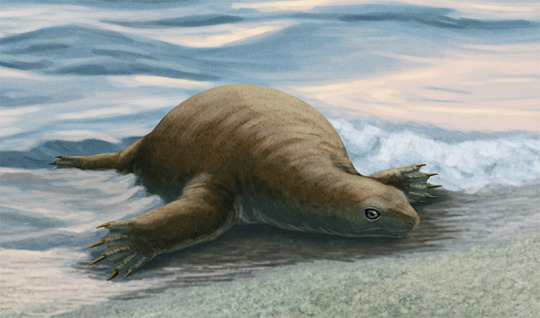
By @alphynix
Etymology: Toothed Turtle
First Described By: Lie et al., 2008
Classification: Biota, Archaea, Proteoarchaeota, Asgardarchaeota, Eukaryota, Neokaryota, Scotokaryota, Opimoda, Podiata, Amorphea, Obazoa, Opisthokonta, Holozoa, Filozoa, Choanozoa, Animalia, Eumetazoa, Parahoxozoa, Bilateria, Nephrozoa, Deuterostomia, Chordata, Olfactores, Vertebrata, Craniata, Gnathostomata, Eugnathostomata, Osteichthyes, Sarcopterygii, Rhipidistia, Tetrapodomorpha, Eotetrapodiformes, Elpistostegalia, Stegocephalia, Tetrapoda, Reptiliomorpha, Amniota, Sauropsida, Eureptilia, Romeriida, Diapsida, Neodiapsida, Sauria, Archosauromorpha?, Archelosauria, Pantestudines, Odontochelyidae
Time and Place: Around 232 million years ago, in the Carnian age of the Late Triassic
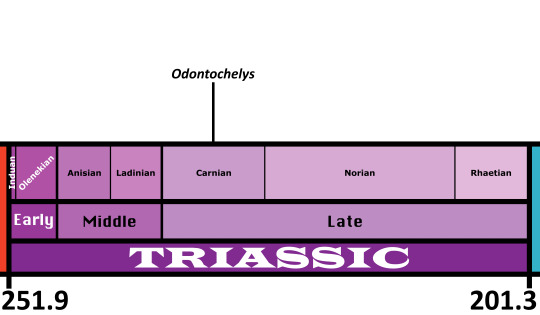
Odontochelys is known from the Lower Member of the Xiaowa Formation of China, commonly known as the Guanling Fauna
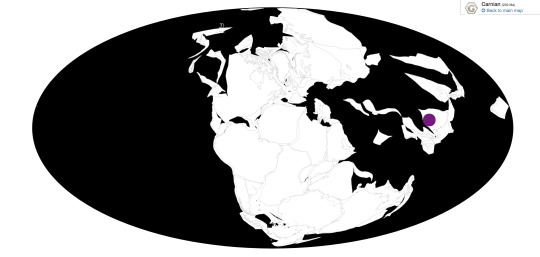
Physical Description: Odontochelys is one of the earliest known turtles - preceded by one, possibly two, precursors other than stem members of the family group - and it showcases how this extremely unique group managed to evolve in the chaos that was the Triassic Explosion. It was simultaneously similar to and very different from living turtles, a true transitional organism. Like other reptiles, it had teeth embedded in its jaws, rather than the toothless beak found in turtle mouths. Like turtles, it had the lower plastron extending from its ribs, but unlike living turtles it had no upper shell - instead, it just had widened ribs and no bony shell around its body. The ribs and the vertebrae were put together differently from modern turtles as well, and its skull was more stretched out compared to its living relatives. It didn’t have fused tail bones, and its scapulae were very different from living turtles. It had short limbs and long, thick fingers, as well as a decently sized shell. It was about forty centimeters long from snout to tail tip.
Diet: The diet of Odontochelys is fairly uncertain, despite us having its teeth; though they are small and peg like, we can’t really extrapolate a function since we don’t actually know its precise ecology! They may have been used for stripping plants, but it’s also possible they were used to chipp up algae and other aquatic water plants, or even invertebrates! So, more research there is clearly needed.
Behavior: The life history of Odontochelys is actually a big mystery. It was found in a marine environment, leading initial studies to indicate it was marine. However, it had the hands of a fresh water organism, including fresh water turtles today. Furthermore, studies of other early turtles indicate that turtles first arose on the land, rather than in the water, and later groups would adapt to water life; the limbs of Odontochelys share similarities with tortoises and support a terrestrial lifestyle. So, the ecology of Odontochelys has been a constant battle. That said, there is some evidence that it was actually marine - and may represent an early experiment in ocean life by turtles. One fossil of Odontochelys indicates that it had completely messed up shoulder bones, likely due to a problem in life rather than destruction of the fossil. This pattern resembles decompression sickness, aka the bends, aka the condition caused by a diving animal coming up much too fast from a lower depth. Modern turtles have complex behavioral adaptations to avoid the bends, so Odontochelys may be an early experiment in marine life in a group mostly adapted for terrestrial life. In this transition to ocean life, it not only lacked better physical adaptations for the ocean, but also better behavioral ones, and was stricken with the bends on its trip back to the surface. So, as we try to determine its ecology and behavior, these clued paint a rich tapestry of the world’s most transitional turtle. A pioneer!
Ecosystem: Odontochelys was found in - and thus, the null hypothesis is that it lived in - an ocean environment near the coast of the Tethys sea. This was a deep, open ocean - pelagic, hence the bends and problems Odontochelys faced trying to deal with the ocean. It was a very fertile ecosystem as well, with a variety of Triassic marine animals showcasing the rapid evolution of these groups. Among the invertebrates, there were many different types of Ammonites, plenty of bivalves, brachiopods, and crinoids & sea cucumbers as well. Still, the fascinating part of the ecosystem was the sheer number of marine reptiles. There were Thalattosaurs such as Anshusaurus and Xinpusaurus; Placodonts like Psephochelys and Sinocyamodus; and Ichthyosaurs like Qianicthyosaurus, Guizhouichthyosaurus, Guanlingsaurus, and Callawayia. One of many beautiful deposits of marine animals from this Period - and the many Ichthyosaurs would have been major predators of the relative n00b Odontochelys.
Other: Odontochelys also just looks really weird because it basically looks like your usual turtle except it doesn’t have a freaking shell so here we are with this oddity. It’s transitional in shape, transitional in ecology, transitional in behavior, and just. What the heck. What the heck, Odontochelys. If you need more proof for evolution despite knowing about the dinosaur - bird transition, have I got a friend for you.
~ By Meig Dickson
Sources Under the Cut
Anquetin, J. 2012. Reassessment of the phylogenetic interrelationships of basal turtles (Testudinata). Journal of Systematic Palaeontology 10(1):3-45.
Bradley Shaffer, H., E. McCartney-Melstad, T. J. Near, G. G. Mount, P. Q. Spinks. 2017. Phylogenomic analyses of 539 highly informative loci dates a fully resolved time tree for the major clades of living turtles (Testudines). Molecular Phylogenetics and Evolution 115: 7 - 15.
Feldmann, R. M., C. E. Schweitzer, S. Hu, J. Huang, Q. Zhang, C. Zhou, W. Wen, T. Xie, E. P. Maguire. 2017. A new Middle Triassic (Anisian) cyclidan crustacean from the Luoping Biota, Yunnan Province, China: morphologic and phylogenetic insights. Journal of Crustacean Biology 37 (4): 406 - 412.
Gilbert, S. F. 2007. How the turtle gets its shell. Biology of Turtles: The Structures to Strategies of Life.
Heiss, E. 2010. Functionality and plasticity of turtle-feeding with special emphasis on oropharyngeal structures. Universitat Wien Doctoral Dissertation.
Hess, H., W. Etter, and H. Hagdorn. 2016. Roveacrinida (Crinoidea) from Late Triassic (early Carnian) black shales of Southwest China. Swiss Journal of Paleontology 135(2):249-274.
Joyce, W. G. 2015. The origin of turtles: A paleontological perspective. Journal of Experimental Zoology Part B: Molecular and Developmental Evolution 324 (3): 181 - 193.
Lee, M. S. Y. 2013. Turtle origins: Insights from phylogenetic retrofitting and molecular scaffolds. Journal of Evolutionary Biology 26 (12): 2729 - 2738.
Lemell, P., N. Natchev, C. J. Beisser, E. Heiss. 2019. Feeding in Turtles: Understanding Terrestrial and Aquatic Feeding in a Diverse but Monophyletic Group. Feeding in Vertebrates: 611 - 642.
Li, C., and O. Rieppel. 2002. A new cyamodontid placodont from Triassic of Guizhou, China. Chinese Science Bulletin 47(5):403-407.
Li, C., X. C. Wu, O. Rieppel, L. T. Wang, and L. J. Zhao. 2008. An ancestral turtle from the Late Triassic of southwestern China. Nature 456:497-501.
Lu, H., D.-Y. Jiang, R. Motani, P.-G. Ni, Z.-Y. Sun, A. Tintori, S.-Z. Xiao, M. Zhou, C. Ji, W.-L. Fu. 2018. Middle Triassic Xingyi Fauna: Showing turnover of marine reptiles from coastal to oceanic environments. Palaeoworld 27 (1): 107 - 116.
Luo, M., Y.-M. Gong, G. R. Shi, Z.-Q. Chen, J. Huang, S. Hu, X. Feng, Q. Zhang, C. Zhou, W. Wen. 2018. Palaeoecological Analysis of Trace Fossil Sinusichnus sinuosus from the Middle Triassic Guanling Formationin Southwestern China. Journal of Earth Science 29: 854 - 863.
Meredith, R. W., J. Gatesy, M. S. Springer. Molecular decay of enamel matrix protein genes in turtles and other edentulous amniotes. BMC Evolutionary Biology 13: 20.
Neenan, J. M., N. Klein, T. M. Scheyer. 2013. European origin of placodont marine reptiles and the evolution of crushing dentition in Placodontia. Nature Communications 4: 1621.
Nicholls, E. L., C. Wei, and M. Manabe. 2002. New material of Qianichthyosaurus Li, 1999 (Reptilia, Ichthyosauria) from the Late Triassic of southern China, and implications for the distribution of Triassic icthyosaurs. Journal of Vertebrate Paleontology 22(4):759-765.
Reisz, R. R., J. J. Head. 2008. Palaeontology: Turtle origins out to sea. Nature 456 (7221): 450 - 451.
Rothschild, B. M., V. Naples. 2015. Decompression syndrome and diving behavior in Odontochelys, the first turtle. Acta Palaeontologica Polonica 60 (1): 163 - 167.
Schoch, R. R., H.-D. Sues. 2015. A Middle Triassic stem-turtle and the evolution of the turtle body plan. Nature 523 (7562): 584 - 587.
Shang, Q.-H., and C. Li. 2009. On the occurrence of the ichthyosaur Shastasaurus in the Guanling biota (Late Triassic), Guizhou, China. Vertebrata PalAsiatica 47(3):178-193.
Vermeij, G. J., R. Motani. 2017. Land to sea transitions in vertebrates: the dynamics of colonization. Paleobiology 44 (2): 237 - 250.
Wang, X., G. H. Bachmann, H. Hagdorn, P. M. Sanders, G. Cuny, X. Chen, C. Wang, L. Chen, L. Cheng, F. Meng, and G. Xu. 2008. The Late Triassic black shales of the Guanling area, Guizhou province, south-west China: a unique marine reptile and pelagic crinoid fossil lagerstätte. Palaeontology 51(1):27-61.
Wang, X., X. Chen, C. Wang, L. Cheng. 2009. The Triassic Guanling Fossil Group - A Key GeoPark from a barren mountain, Guizhou Province, China. Notebooks on Geology 3: Chapter 2: 11 - 28.
324 notes
·
View notes
